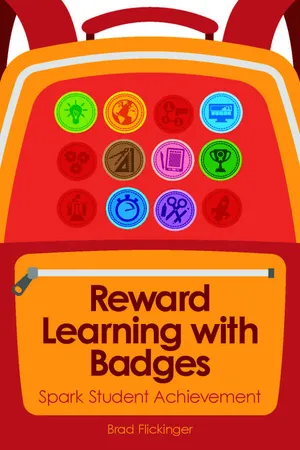
- English
- ePUB (mobile friendly)
- Available on iOS & Android
About this book
This accessible guide shares how and why badges work and the secrets to designing great challenges that motivate students to build skills and take control of their learning. As an elementary technology teacher, author Brad Flickinger observed that his students had little motivation to use the devices surrounding them for anything other than gameplay and entertainment. His solution was to rethink his teaching, adding elements of gamification, challenge-based learning, design thinking and other approaches to learning.With this, the badge system was born. By incorporating badges, students are motivated by using the familiar challenges of gameplay as they earn visual indicators of progress and complete challenges. At the same time, they are mastering skills and progressing academically. Reward Learning with Badges shows how to implement a successful badging system in your classes. You'll learn to think differently about motivation and achievement and prepare to embark on your own badging initiative.The book includes:
- Step-by-step planning advice
- Tips on implementation and technology
- Support from examples and success stories
With this book, you'll learn everything you need to know to start badging, including how to introduce badging to students, faculty and parents; how to design physical and digital badges; how to relate badges to standards and curricular goals and more. Audience: K-8 classroom teachers
Frequently asked questions
- Essential is ideal for learners and professionals who enjoy exploring a wide range of subjects. Access the Essential Library with 800,000+ trusted titles and best-sellers across business, personal growth, and the humanities. Includes unlimited reading time and Standard Read Aloud voice.
- Complete: Perfect for advanced learners and researchers needing full, unrestricted access. Unlock 1.4M+ books across hundreds of subjects, including academic and specialized titles. The Complete Plan also includes advanced features like Premium Read Aloud and Research Assistant.
Please note we cannot support devices running on iOS 13 and Android 7 or earlier. Learn more about using the app.
Information
CHAPTER ONE
Inspiration for the Badge System
Influential Books
Literacy Is Not Enough:
21st Century Fluencies for the Digital Age
Flip Your Classroom:
Reach Every Student in Every Class Every Day
Learning Models and Approaches
Challenge-Based Learning
Gamification

The Hacker Mindset
The Growth Mindset
Table of contents
- Cover
- Title Page
- Copyright
- About ISTE
- About the Author
- Contents
- Introduction
- CHAPTER ONE: Inspiration for the Badge System
- CHAPTER TWO: Overview of the Badge System
- CHAPTER THREE: How Does the Badge System Work?
- CHAPTER FOUR: Creating Your Own Badge System
- CHAPTER FIVE: Creating Individual Badge Challenges
- CHAPTER SIX: Implementation Tips
- CHAPTER SEVEN: A Word About Technology
- CHAPTER EIGHT: Success Stories
- CHAPTER NINE: Frequently Asked Questions
- References